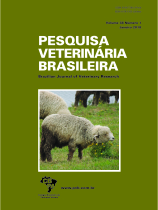 |
|
|
|
Year 2018 - Volume 38, Number 1
|

|
Profile of Taenia saginata cysticerci implantation in unusual sites and its importance for public health, 38(1):23-28
|
ABSTRACT.- Guimarães Peixoto R.P.M., Pinto P.S.A., Santos T.O., Silva L.F., Acevedo-Nieto E.C. & Silva A.R. 2018. [Profile of Taenia saginata cysticerci implantation in unusual sites and its importance for public health.] Perfil da implantação de cisticercos de Taenia saginata em sítios musculares não usuais e sua importância para a Saúde Pública. Pesquisa Veterinária Brasileira 38(1):23-28. Departamento de Veterinária, Laboratório de Inspeção de Produtos de Origem Animal, Universidade Federal de Viçosa, Campus Universitário, Av. PH Rolfs s/n, Viçosa, MG 36570-000, Brazil. E-mail: pintopsa@ufv.br
Cysticercosis is a worldwide zoonosis, which demands proper control and monitoring during all beef production chain. In Brazil, the key point for controlling this zoonosis is the anatomopathological exam conducted in slaughterhouses during the post-morten inspection. This study aimed to describe the cysticerci location in tissues not usually examined during the inspection, and to check their viability in bovines infected with Taenia saginata eggs (group 1: experimental; group 2: natural). After slaughtering, animal from both groups were routinely examined for cysticercosis, according official Brazilian standards; group 1 animals were also examined in additional anatomic regions: end cuts (chuck, rump, strip loin, and shoulder), liver, esophagus, diaphragm and pillars. In group 1, cysticerci were identified in chuck (8.2%), shoulder (6.6%), strip loin (6.2%), and rump (5.8%), and also in tissues that are not usually considered during routine inspection, such as diaphragm (2.7%), liver (12.0%) and esophagus (1.2%). Still in group 1, the routine inspection identified cysticerci in hearth (37.7%), head muscles (17.1%), and tongue (2.3%). In group 2, cysticerci were identified in hearth (61.8%), head muscles (38.2%), and liver (10.2%). The viability of cysticerci were predominant in rump (80.0%), diaphragm (71.4%) and esophagus (66.7%) in animals from group 1, while non-viable cysticerci were more frequent in head muscles (77.3%), hearth (76.3%), liver (71.0%), and tongue (50.0%). In group 2, head muscles presented 68.3% of the viable cysticerci, while non-viable cysticerci were identified in liver (87.5%), tongue (66.7%), and hearth (63.2%). The high frequencies of viable cysticerci in end cuts available for consumers, including natural infected bovines, is a Public Health concern, once in Brazil these products were usually consumed without proper heat treatment, increasing the risks of T. saginata infection. The obtained results demonstrated the anatomopathological distribution of cysticercosis in different tissues in experimental and natural infected bovines, considering tissues that are routinely and not routinely examined during inspection. Then, the inspection procedures could be improved by adding such analysis in its routine procedures, in order to increase the proper control of the taeniasis-cysiticercosis complex and to decrease the Public Health risks. |
| |
|
|
| |
|
 |